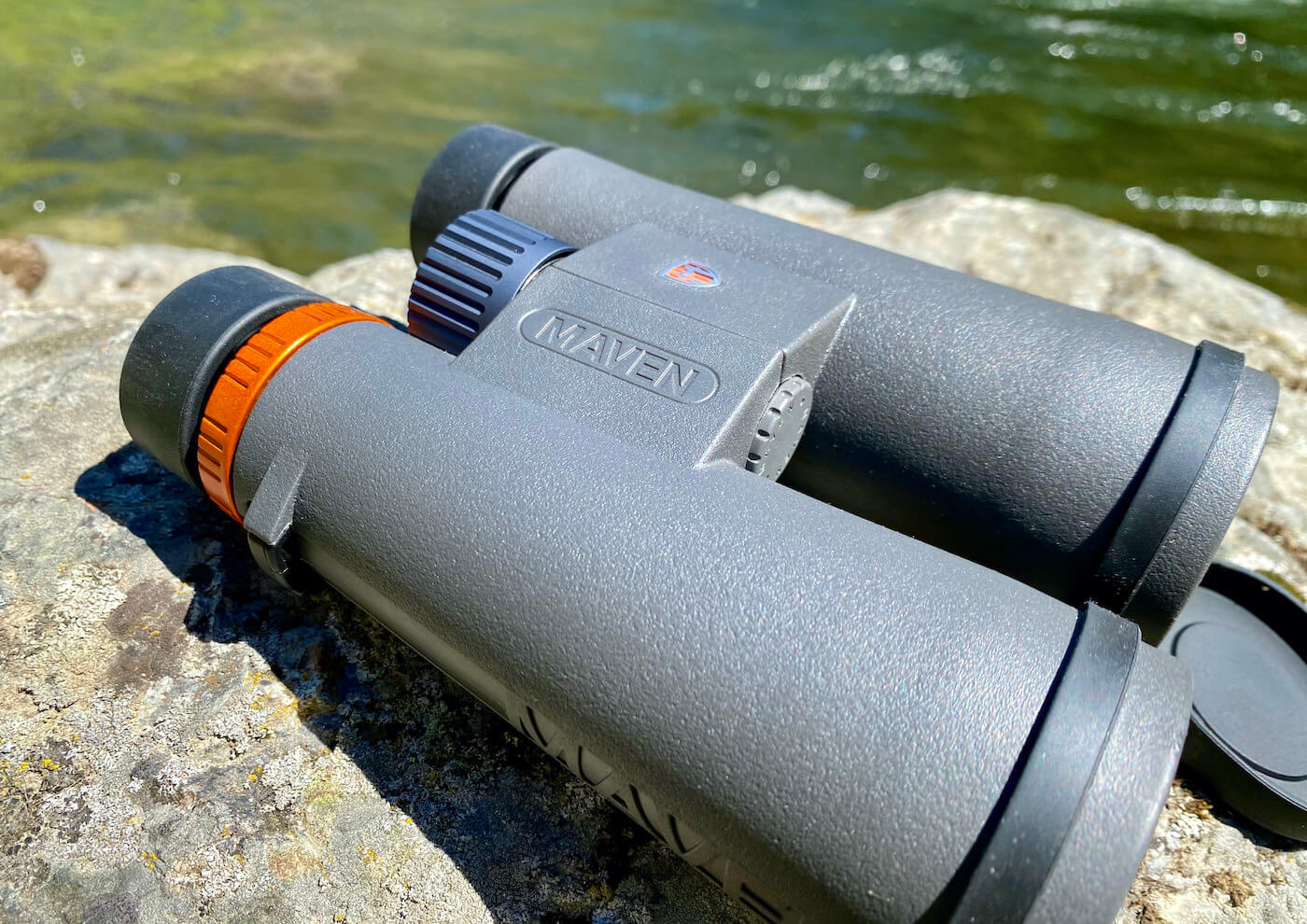The Maven C.3 Binoculars are a mid-level, direct-to-consumer optic with a 50mm objective lens for improved light transmission. They also come with an excellent no-fault lifetime warranty.
To get us a closer look — and to let us compare the Maven 10×50 C.3 head-to-head with the 10×42 C.1 binoculars — Maven sent Man Makes Fire a review unit. After field testing during our review process, this is what we learned:
Maven C.3 10×50 Review
Maven is a relatively small optics company that has generated a solid fan base since 2014. The Wyoming-based company has a mission to deliver world-class optics through it’s direct-to-consumer business model. Maven makes binoculars, spotting scopes, riffle scopes, and rangefinders. You can buy Maven products directly from the company’s online store, as well as via its Amazon store (just make sure the seller is “Mavenbuilt” in the Amazon listing so you know it’s legit).
Over the last couple of years, I’ve hunted with, and reviewed, the Maven B.1 10×42 and Maven C.1 10×42 binoculars.
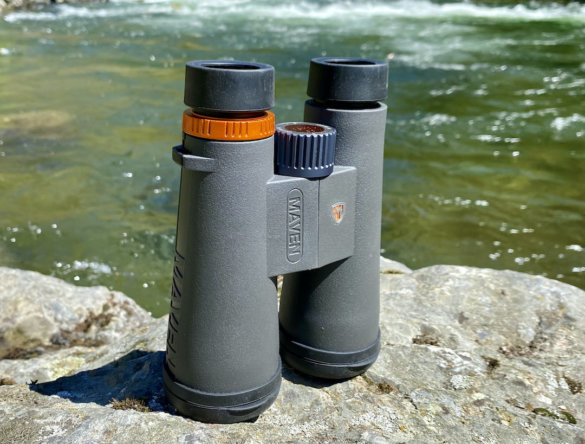
For this review, I’m going to cover the key design features and specifications of the C.3 first, then share some comparison testing results. In particular, I’ll compare the Maven 10×42 C.1 binoculars to the 10×50 C.3 binoculars, as well as to the Maven B.1 10x42s. But first, the C.3 model:
The Maven C.3 binoculars come in two versions, 10×50 ($400) and 12×50 ($425). Maven’s C-series optics represent the company’s lowest priced products, which are actually midrange-level optics when compared to the whole industry.
The C.3 binoculars deliver very good clarity and color through fully-multicoated lens and extra-low dispersion ED glass. In case you’re wondering, “HD” glass is also essentially ED glass. When it comes to binoculars, ED and HD are quite a bit better than standard glass. What does ED glass do? It helps cut down on chromatic aberrations and delivers clearer images. You want ED or HD glass.
Build Quality
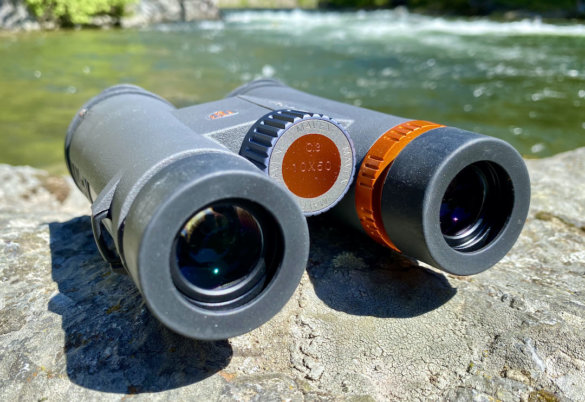
If you want more detail on the build quality, I encourage to also read my review of the Maven C.1 10×42 binoculars. The short build quality answer is this: The Maven C.3s are waterproof, fog proof, and have a durable, rubberized lightweight polymer frame. Overall, the fit and finish is very good.
The focus wheel is smooth and easy to use. The diopter adjustment ring — which is the orange ring on the right side barrel — is fairly stiff (but this means that it also stays put after you set it).
The twist-up, multi position eye cups are good. They have a tendency to rotate and slip back down to another position when you’re handling the binoculars. For instance, when you’re looking through the binoculars, the eye cups stay put — but if you put them in and out of a bino chest pack over and over again, you’ll end up bump-twisting the eye cups. Some guys might get annoyed at this, but I’ve been willing to overlook it because the price-to-value ratio is so high.
Overall, the C-series binoculars are handsome and functional. I’m a fan and recommend the C-series to anyone who is looking for quality optics on a midrange budget.
C.3 vs C.1 Comparison: 10×50 vs 10×42
I’ve always wanted to get a set of 10×42 binoculars side-by-side with 10×50 binoculars to see how much difference the larger objective lens will make in low-light viewing. And really, that’s the key point for 10×50 binoculars. Why go with something that’s larger and heavier than 10×42 if there isn’t a benefit? So what is that real-world benefit? I wanted to find out.
In order for this comparison to be worthwhile, you need to compare essentially the same manufacturer’s models of binoculars that have extremely similar glass, coatings, and overall quality.
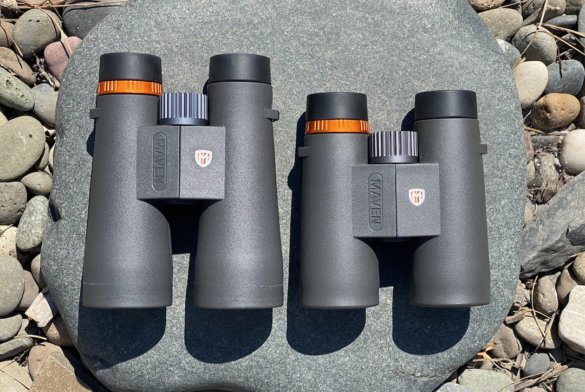
I’m guessing you already know this, but if you divide the large objective lens diameter by the power of magnification, you’ll get an “Exit Pupil” calculation. For instance, 42 divided by 10 equals an exit pupil calculation of 4.2. Similarly, 50 divided by 10 equals 5.0. Basically, exit pupil refers to the diameter of light that can pass through the binoculars to your eye. Bigger exit pupil calculations let more light make it to your eye, which should result in a more visible image in low-light conditions.
Why did I saw low-light conditions? In the middle of the day in bright sun, your pupils will constrict to protect your eyes by reducing the amount of light that gets in. So if your pupils are constricted to 3 millimeters, for instance, it doesn’t matter if the exit pupil is larger than 3 mm. Only a 3 mm swath of light will enter your eye if your pupils are constricted to 3 mm. Pupils typically can range in size from 2-to-8 mm — but aging eyes tend to lose some elasticity, which might be a reason why some older men seem to appreciate better glass more than younger guys. (Although, bigger budgets might also be a factor.)
In low-light conditions, your pupil might be dilated to 6 mm. In this situation, a binocular with a 5.0 exit pupil calculation can physically deliver a broader beam of light to your eye than one with a 4.2 exit pupil calculation.
Are 10×50 Binoculars Brighter than 10×42?
Here are the real questions I wanted to answer with this review: Are 10×50 binoculars noticeably brighter than 10×42 binoculars? And, if they are brighter, does that make 10×50 binoculars better than 10×42 binoculars?
The short answer is that, everything else being equal, 10×50 binoculars will seem brighter in low-light situations than 10×42 binoculars. However, is it truly useful and easily noticed? Is there a big difference that justifies the extra size, weight, and cost?
Testing the C.3, C.1 and B.1 Binoculars
To find the answer, I first tested a 10×50 C.3 binocular side-by-side with the 10×42 C.1. During the middle of the day, in bright light, I looked at a wide variety of objects and found few differences in quality. The color, contrast, and clarity were very similar.
That said, the 10×50 C.3 has a much smaller FOV — the field of view is 262 feet at 1,000 yards compared to the 10×42 C.1’s 314′ FOV. This means that the circular sight picture is smaller in the C.3 binoculars. The premium 10×42 B.1s have an FOV of 341, which further exacerbated this difference. For hunting purposes, if you’re scanning a hillside for an animal, you have a smaller image with which to have something catch your eye as you look.
In addition, there is a bit of edge blur in the C.3 and C.1, so you’re really looking using the middle sweet spot of each binocular’s image. In the middle of the day, I preferred the bigger, more immersive image from the 10×42 binoculars vs the 10×50. So FOV is a factor of overall usability here, and the smaller C.3 FOV is a drawback.
Twilight Testing
Here’s where the 10×50 vs 10×42 comparison got more interesting — at twilight. More specifically, the difference was most noticeable in the last few minutes of available light. I tested the three Maven binoculars side-by-side over several nights, looking at a wide variety of subjects. I checked out far away barns, animals in and out of shadow, the detail of bark, high-contrast tree branches against the sky, and even street signs, which sometimes illuminate clarity differences. I also spent one twilight evening examining a USAF black-and-white test chart taped to my garage door.
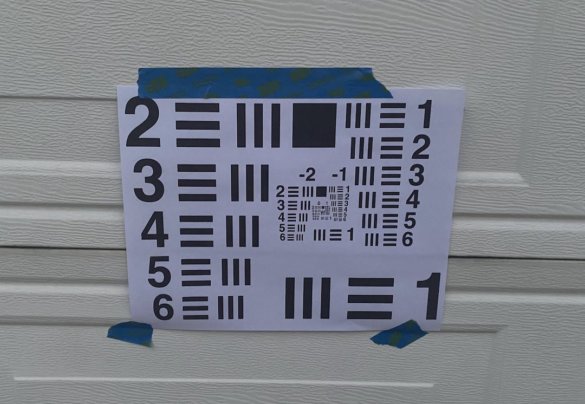
In Idaho, legal shooting light is 30 minutes before sunrise and 30 minutes after sunrise. Now, I wasn’t able to test the binoculars in every kind of weather. Certainly heavy cloud cover could change things a bit. In lightly overcast skies, in fairly open terrain, the 10×50 C.3 seemed very slightly brighter than the 10×42 C.1. And I mean very slightly. I could only find the difference by swapping back-and-forth between the two binoculars and looking hard for it. More importantly, during legal shooting light, I had a hard time imagining a situation where the C.1 could not deliver the information I’d need while hunting.
To clarify, during legal shooting light the brightness difference between the 10×50 C.3 and 10×42 C.1 is very small and hard to identify. Technically, there is about a 16% difference in the exit pupil size, but that doesn’t translate to 16% more brightness. In fact, in the real world, 30 minutes before sunrise and 30 minutes after sunrise, the difference seemed negligible to me.
But what about after legal shooting light? What about when it’s almost dark? Does the difference become more noticeable?
Yes, it does, but we’re still splitting hairs. As the light fades, the 10×50 C.3 seemed very slightly brighter than the 10×42 C.1. Seriously, the low-light brightness difference between 10×50 and 10×42 was much smaller than I expected. Why might this be?
Quality Glass and Great Coatings
I suspect that the 10×50 vs 10×42 difference would be more noticeable between lesser quality binoculars. Because the C-series line uses ED glass and has modern fully-multicoated lenses using Maven’s secret coatings recipes, a lot of light is already getting through to your eyes.
In case this isn’t clear, binoculars don’t really amplify available light — they’re not like night vision goggles. They just let it come in and try not to lose any refracted light as it passes through lenses to your eyes. In this respect, weak light coming through a slightly wider opening doesn’t necessarily radically change how your brain processes that weak light. It’s still weak twilight light. Again, as near as I can tell, we’re not like smartphone image processors that adjust for low light photos and generate brighter images on your screen. The key reason a magnified image might seem brighter — compared to the naked eye — is the fact that it’s magnified to appear closer.
So what other information might we consider to help illustrate what’s going on?
Maven publishes a massive — and impressive — Maven binocular comparison chart. The chart reports standard specifications, but it also includes a light transmission percentage. Here are three light transmission specifications:
- C.3 10×50: 90.00%
- C.1 10×42: 89.00%
- B.1 10×42: 90.90%
So, from a light transmission comparison, all three binoculars are very good. They’re letting nearly the same percentage of light through. If I understand this right, the only comparison that makes sense here is the apples-to-apples C.1 to B.1 because they are both 10×42. If you think of the light transmission here, it’s sort of like comparing two garden hoses with different diameters. You could throttle the hoses to the same percentages of volume, but the larger hose will still deliver more water. Technically.
Does this light transmission specification mean anything? Yes. The B.1 is slightly brighter than the C.1. But it doesn’t mean that the C.3 is necessarily brighter or less bright than the other two.
Here is another measurement specification that might not be that important to binoculars at this level of quality and similar sizes: Twilight Factor. This particular specification tries to offer another physical measurement illustration of how well the lenses might come together to perform in low light. Twilight Factors:
- C.3 10×50: 22.4
- C.1 10×42: 20.5
- B.1 10×42: 20.5
As you can see, these numbers are similar. The 10×42 binos shared the same calculation . . . and yet, the B.1 is slightly brighter and clearer than the C.1 . . . due to better overall components and build quality and maybe to slightly different lens combinations and positions.
Moving on, there is Brightness, which is calculated by squaring the exit pupil number. Maven reports these brightness specifications:
- C.3 10×50: 25
- C.1 10×42: 17.6
- B.1 10×42: 17.6
So are these numbers useful? On paper it seems as if the 10×50 C.3 should be much brighter than the 10×42 C.1 — and even brighter than the 10×42 B.1. But that’s not the case in the real world — at least for me, with my eyes. This seems to be a situation where a calculated specification doesn’t have much to do with actual real-world performance.
I only bring this up because Maven produces such a cool comparison chart. Few other companies make these charts, and in fact, some companies don’t bother to report much information at all. Maven does. I appreciate that. The downside is that the chart could introduce factors that might influence decisions . . . when, as I’ve learned here, some of these numbers don’t matter much when you’re dealing with quality lens constructions in the first place.
What About the Lenses?
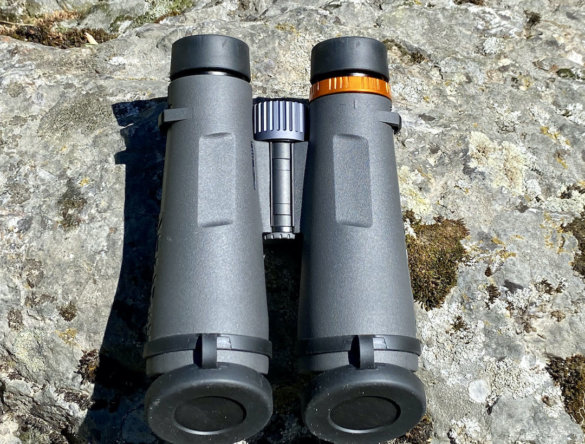
This comparison still isn’t as 1-to-1 as you might think. As it turns out, the lens constructions are slightly different, despite the overall similarities. The ocular lens construction in the C.1 is made of 3 groups with 4 elements while the C.3 is made from 2 groups with 3 elements. That means there is at least one less piece of glass inside the C.3 vs the C.1. That could be good or bad. More lens elements can sometimes correct images but they can also sometimes reduce light passthrough if they’re not quality components.
What About My Own Eyes?
One possibility of the small noticeable difference could be that my aging eyes are not dilating all the way to 5 mm. While I now need reading glasses to focus up close when tying on small flies while fly fishing — like every guy well into his forties — my vision is otherwise excellent. To test this theory, I went into a dark bathroom and waited a couple minutes for my eyes to adjust. I then turned on a soft light so I could glimpse the size of my pupils in the mirror. I didn’t hold up a 5.56 round as a comparison, but my non-optometrist estimation is that my pupils were at least 5mm dilated, if not a bit more. Still, it’s possible that older guys might not be able to perceive brightness differences as well as younger guys. In which case that sucks, but it’s still good information for older guys. Maybe 10×50 binoculars perform better for younger people with younger eyes. Maybe.
Want to try your own test? Check out Maven’s ‘Demo Optics’ program!
C.3 10×50 Benefits and Drawbacks
For me, the whole point of this exercise is to figure out if the 10×50 option with the larger exit pupil creates a better binocular for hunting. Because low-light situations are important to many hunting situations, any binocular that produces better low-light performance is worth a look. But is the C.3 10×50 low-light performance benefits worth the drawbacks?
Before this test, I believed that a small boost in low-light performance would be worth a slightly higher price point and worth the slightly heavier weight and larger size typically found in 10×50 binoculars. After this test, I now know that the nearly imperceptible low-light performance boost isn’t particularly useful for me personally. For the record, I hunt deer and elk in Idaho, which includes a mix of wide open terrain with medium and short distances, sometimes in dark timber but usually around mixed cover.
The FOV Drawback
The biggest issue for me, at least when it comes to binoculars used for hunting, is the FOV. The field of view in the C.3 is quite a bit smaller than the C.1 and B.1. This translates to a less immersive image with a smaller sweet spot.
- C.3 10×50 FOV: 262′
- C.1 10×42 FOV: 314′
- B.1 10×42 FOV: 341′
Ultimately, the overall usability of the C.1 10×42 and B.1 10×42 outperform the C.3 10×50. After this test, I know that I’d rather use the 10×42 binoculars over the 10×50 binoculars for elk and deer hunting.
Differences with Cheap Binoculars?
After this experience, I’m guessing that high-end binoculars will deliver similar hard-to-notice performance results. What I don’t know is if this premise holds true with cheaper entry-level binoculars. If the lens quality and coatings and construction isn’t as good in an entry-level binocular, might the sheer physics of a larger objective lens produce a more notable low-light boost? I don’t know. Again, chances are that the physical orientation of the lens groups will create differences that amplify or mitigate the physical calculations around the magnification and objective lens diameter — like exit pupil.
What About the B.1?
Editor’s Note: Maven has since upgrade its B.1 binoculars into it’s new B1.2 binoculars! The new B1.2 version is lighter, more compact, brighter, and has a wider Field of View. To learn more, check out our full Maven B1.2 Binocular Review here.

The B.1 binoculars represent a much higher overall quality binocular than the C-series binoculars. I found that — while the C.3 produced good brightness compared to the B.1 binoculars — the overall clarity of the B.1 was better, which resulted in slightly better low-light results. The C.3 let me identify details almost as well as the B.1, but frankly, it seemed easier on my eyes and brain to do it with the B.1. Plus, the image seemed richer and more immersive with the B.1. In this case, the common optics recommendation rule remains true: Always buy the best glass you can afford.
Want to try your own test? Check out Maven’s ‘Demo Optics’ program!
The Verdict: Three Key Points
First, the Maven C.3 binoculars are very good midrange binoculars. They compete very well with binoculars that cost a bit more, and they’re a couple of solid steps better than most entry-level binoculars that cost less. The price-to-value ratio is excellent. They’re very similar to the C.1 line, which is easy to recommend.
Second, the 262′ of FOV was disappointing. This might not be an issue for birders, but for me, for big game hunting where I hunt, it wasn’t as wide as I want.
Third, the greater objective lens size did not translate to significantly better low-light performance compared to similar Maven binoculars that use, presumably, similar coatings and lens qualities. At least, we’re talking about what I could detect with my eyes. If I absolutely had to judge antler tines after legal shooting light in the last few minutes of perceptible light, I would pick the C.3 10×50 over the C.1 10×42. For everyday use, however, I’d pick the C.1 10×42 for the better FOV, smaller size, and lower price point. Either way, the C-series Mavens are great midrange binoculars at a competitive price point. Highly recommended.
Get the Gear:
Note: You can also shop some Maven optics on Maven’s Amazon Store.
Looking for hunting gifts? Check out our guide to the best gifts for hunters!

